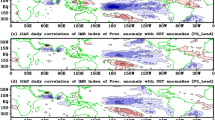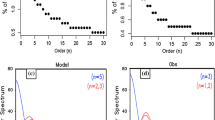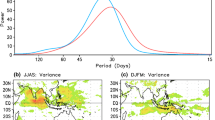Abstract
The leading modes of daily variability of the Indian summer monsoon in the climate forecast system (CFS), a coupled general circulation model, of the National Centers for Environmental Predictions (NCEP) are examined. The space–time structures of the daily modes are obtained by applying multi-channel singular spectrum analysis (MSSA) on the daily anomalies of rainfall. Relations of the daily modes to intraseasonal and interannual variability of the monsoon are investigated. The CFS has three intraseasonal oscillations with periods around 106, 57 and 30 days with a combined variance of 7%. The 106-day mode has spatial structure and propagation features similar to the northeastward propagating 45-day mode in the observations except for its longer period. The 57-day mode, despite being in the same time scale as of the observations has poor eastward propagation. The 30-day mode is northwestward propagating and is similar to its observational counterpart. The 106-day mode is specific to the model and should not be mistaken for a new scale of variability in observations. The dominant interannual signal is related to El Niño-Southern Oscillation (ENSO), and, unlike in the observations, has maximum variance in the eastern equatorial Indian Ocean. Although the Indian Ocean Dipole (IOD) mode was not obtained as a separate mode in the rainfall, the ENSO signal has good correlations with the dipole variability, which, therefore, indicates the dominance of ENSO in the model. The interannual variability is largely determined by the ENSO signal over the regions where it has maximum variance. The interannual variability of the intraseasonal oscillations is smaller in comparison.













Similar content being viewed by others
References
Achuthavarier D, Krishnamurthy V (2010) Relation between intraseasonal and interannual variability of the South Asian monsoon in the NCEP forecast systems. J Geophys Res 115. doi:10.1029/2009JD012865
Charney JG, Shukla J (1981) Predictability of monsoons. In: Lighthill J, Pearce RP (eds) Monsoon dynamics. Cambridge University Press, Cambridge, pp 99–109
Drbohlav, H-KL, Krishnamurthy V (2010) Spatial structure, forecast errors and predictability of South Asian monsoon in CFS monthly retrospective forecasts. J Climate. doi:10.1175/2010JCL12356.1
Ghil M, Allen MR, Dettinger MD, Ide K, Kondrashov D, Mann ME, Robertson AW, Saunders A, Tian Y, Varadi F, Yiou P (2002) Advanced spectral methods for climatic time series. Rev Geophys 40. doi:10.1029/2000RG000092
Goswami BN, Krishnamurthy V, Annamalai H (1999) A broad-scale circulation index for the interannual variability of the Indian summer monsoon. Q J R Meteorol Soc 125:611–633
Hartmann DL, Michelsen ML (1989) Intraseasonal periodicities in Indian rainfall. J Atmos Sci 46:2838–2862
Kanamitsu M, Ebisuzaki W, Woollen J, Yang SK, Hnilo JJ, Fiorino M, Potter G (2002) NCEP-DOE AMIP-II reanalysis. Bull Am Meterol Soc 83:1631–1643
Kemball-Cook S, Wang B, Fu X (2002) Simulation of the intraseasonal oscillation in the ECHAM-4 model: the impact of coupling with an ocean model. J Clim 14:2923–2942
Krishnamurthy V, Kinter JL III (2003) The Indian monsoon and its relation to global climate variability. In: Rodó X, Comín FA (eds) Global climate. Springer, Berlin, pp 186–236
Krishnamurthy V, Kirtman BP (2009) Relation between Indian monsoon variability and SST. J Clim 22:4437–4458
Krishnamurthy V, Shukla J (2000) Intraseasonal and interannual variability of rainfall over India. J Clim 13:4366–4377
Krishnamurthy V, Shukla J (2007) Intraseasonal and seasonally persisting patterns of Indian monsoon rainfall. J Clim 20:3–20
Krishnamurthy V, Shukla J (2008) Seasonal persistence and propagation of intraseasonal patterns over the Indian monsoon region. Clim Dyn 30:353–369
Moorthi S, Pan H-L, Caplan P (2001) Changes to the 2001 NCEP operational MRF/AVN global analysis/forecast system. In: NWS Tech Procedures Bulletin (available online at http://www.nws.noaa.gov/om/tpb/484.htm)
Moron V, Vautard R, Ghil M (1998) Trends, interdecadal and interannual oscillations in global sea-surface temperatures. Clim Dyn 14:545–569
Pacanowski RC, Griffies SM (1998) MOM 3.0 manual. NOAA/GFDL (available online at http://www.gfdl.noaa.gov/~smg/MOM/web/guide_parent/guide_parent.html)
Pegion K, Kirtman BP (2008) The impact of air–sea interactions on the simulation of tropical intraseasonal variability. J Clim 21:6616–6635
Ramamurthy K (1969) Some aspects of the break in the Indian southwest monsoon during July and August. Forecasting Manual, Part IV—18.3, India Meteorological Department
Saha S, Nadiga S, Thiaw C, Wang J, Wang W, Zhang Q, van den Dool HM, Pan HL, Moorthi S, Behringer D, Stokes D, White G, Lord S, Ebisuzaki W, Peng P, Xie P (2006) The NCEP climate forecast system. J Clim 15:3483–3517
Saji NH, Goswami BN, Vinayachandran PN, Yamagata T (1999) A dipole mode in the tropical Indian Ocean. Nature 401:360–363
Seo KH, Schemm JKE, Wang W, Kumar A (2007) The boreal summer intraseasonal oscillation simulated in the NCEP climate forecast system: the effect of sea surface temperature. Mon Weather Rev 135:1807–1827
Sikka DR, Gadgil S (1980) On the maximum cloud zone and the ITCZ over Indian longitudes during the southwest monsoon. Mon Weather Rev 108:1840–1853
Waliser DE, Jin K, Kang I-S, Stern WF, Schubert SD, Lau K-M, Lee M-I, Krishnamurthy V, Kitoh A, Meehl GA, Galin VY, Satyan V, Mandke SK, Wu G, Liu Y, Park C-K (2003) AGCM simulations of intraseasonal variability associated with the Asian summer monsoon. Clim Dyn 21:423–446
Yasunari T (1979) Cloudiness fluctuations associated with the Northern Hemisphere summer monsoon. J Meteorol Soc Jpn 57:227–242
Zheng Y, Waliser DE, Stern WF, Jones C (2004) The role of coupled sea surface temperatures in the simulation of the tropical intraseasonal oscillation. J Clim 17:4109–4134
Acknowledgments
This research was supported by grants from the National Science Foundation (ATM-0332910, ATM-0830062, ATM-0830068), the National Oceanic and Atmospheric Administration (NA04OAR4310034, NA09OAR4310058), and the National Aeronautics and Space Administration (NNG04GG46G, NNX09AN50G). The authors thank Kathy Pegion for sharing the model data and Ben Kirtman for helpful discussions. This work formed a part of the Ph.D. thesis of Deepthi Achuthavarier submitted to George Mason University.
Author information
Authors and Affiliations
Corresponding author
Rights and permissions
About this article
Cite this article
Achuthavarier, D., Krishnamurthy, V. Daily modes of South Asian summer monsoon variability in the NCEP climate forecast system. Clim Dyn 36, 1941–1958 (2011). https://doi.org/10.1007/s00382-010-0844-9
Received:
Accepted:
Published:
Issue Date:
DOI: https://doi.org/10.1007/s00382-010-0844-9




